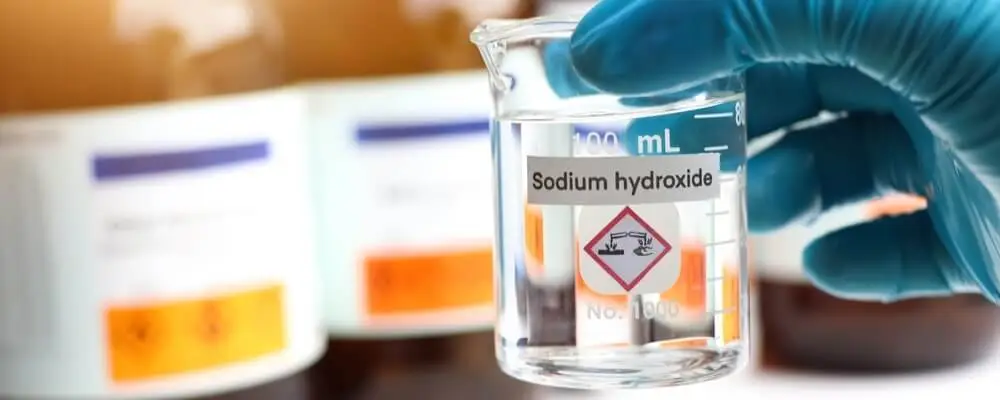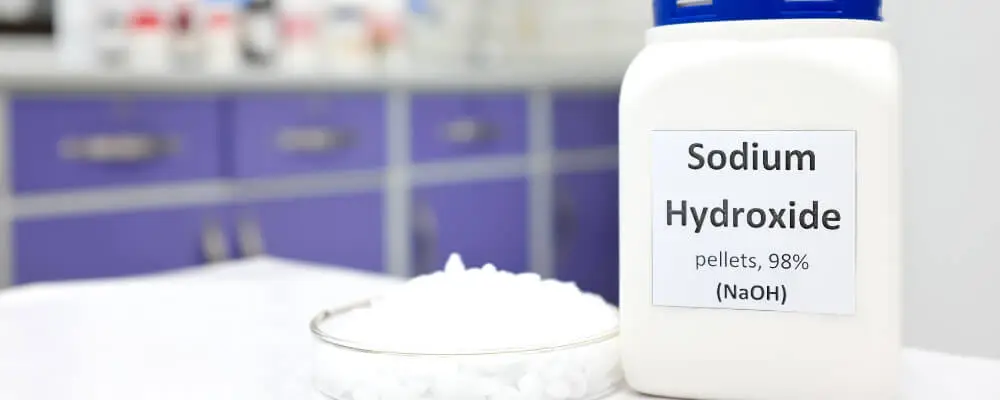Understanding the potential hazards of commonly used chemicals in industrial and laboratory safety is key to maintaining a secure work environment. Sodium hydroxide, often known as lye or caustic soda, is one such substance. Its versatility makes it a staple in various industries ranging from soap and detergent production to food processing, water treatment, and papermaking. However, the powerful nature of this alkali demands a high degree of caution.
This blog post is designed to shed light on the risks associated with sodium hydroxide and provide guidance on handling this compound safely. It’s essential for those who encounter this substance, whether frequently or infrequently, to be fully aware of the potential hazards and how to mitigate them.
This blog will be a valuable resource for seasoned professionals, students, and anyone interested in chemical safety by addressing each hazard in detail and providing practical control measures. So let’s dive into sodium hydroxide, exploring its risks and learning how to navigate its use responsibly.
Sodium Hydroxide (NaOH)
Sodium hydroxide, or lye or caustic soda, is a highly caustic and reactive inorganic compound with NaOH chemical formula. It’s an alkali, which means it’s basic in nature. In its pure form, sodium hydroxide appears as a white solid, often in pellets, flakes, or granules. It is highly soluble in water, with the dissolution process generating heat.
Sodium hydroxide is widely used in many industries due to its strong alkaline properties. Some common uses include:
- Soap and Detergent Production: Sodium hydroxide is used in saponification, turning fats and oils into soap. It’s also a component of many detergents.
- Chemical Manufacturing: Sodium hydroxide produces various chemicals, including solvents, plastics, and fabric dyes.
- Paper Industry: Sodium hydroxide is used in papermaking, breaking down wood chips into pulp.
- Water Treatment: Sodium hydroxide can neutralize acidic water and remove heavy metals from water.
- Food Processing: Sodium hydroxide is used in food processing for various purposes, such as peeling fruits and vegetables, processing cocoa and chocolate, and producing caramel color.
- Aluminium Ore Processing: Sodium hydroxide is used in the Bayer process of aluminum ore processing.
While sodium hydroxide has many beneficial uses, it’s a highly corrosive substance that can cause severe burns and eye damage and should be handled carefully. It’s also harmful to aquatic life with long-lasting effects. Therefore, appropriate safety measures and disposal procedures are vital when working with this chemical.

Sodium Hydroxide Hazards and Control Measures
Sodium hydroxide, also known as caustic soda or lye, is a strong base used in many industrial processes. It can be hazardous if not handled correctly. Here are 10 hazards associated with sodium hydroxide (NaOH) and measures to control them:
1. Skin and Eye Irritation
Sodium hydroxide is a strong alkali, and it is highly caustic. If it comes into contact with the skin or eyes, it can react with natural oils and moisture, causing significant irritation or severe burns. Individuals handling sodium hydroxide should always use PPE to prevent these injuries. This includes wearing gloves made from materials resistant to alkali (like nitrile), chemical safety goggles to prevent splashes from reaching the eyes, and protective clothing or lab coats to protect skin from accidental spills or splashes.
2. Chemical Burns
Sodium hydroxide can react with the skin and cause chemical burns. These burns can range from mild irritation to severe tissue damage, depending on the concentration and duration of exposure. Protective barriers such as chemical-resistant aprons, face shields, and gloves should be used to prevent direct contact with skin. Immediately washing off any sodium hydroxide that comes into contact with the skin can also help minimize injuries.
3. Inhalation Hazards
When sodium hydroxide is in a solid state, it can generate dust. In solution, it can create aerosols, both of which can cause damage to the respiratory tract if inhaled. Ensuring adequate ventilation, especially in enclosed spaces, can help to minimize this risk. Where ventilation is inadequate or during tasks that generate dust or aerosols, respirators or dust masks designed for chemical exposure should be used.
4. Ingestion Hazards
Ingestion of sodium hydroxide can cause serious harm, leading to mouth, throat, and gastrointestinal tract burns. Preventive measures include storing sodium hydroxide in clearly labeled containers to avoid confusion and strictly maintaining a policy of no food, drink, or smoking in areas where chemicals are used. Regular safety training should be carried out to educate workers about the hazards and the necessary precautions.
5. Chemical Reactions
Sodium hydroxide can react violently with acids, producing a large amount of heat that can lead to fire or explosion. It can also react with some metals to produce hydrogen gas, which is flammable. To prevent such hazardous reactions, sodium hydroxide should be stored separately from acids and reactive metals.
All storage containers should be clearly labeled, and the storage area should be regularly inspected for signs of damage or leaks. Additionally, safety protocols should be in place for handling and mixing chemicals to prevent accidental reactions.
6. Environmental Hazard
Sodium hydroxide can harm aquatic life due to its high pH, dramatically altering the water’s natural pH level and disrupting the balance of life forms in the ecosystem. It is crucial to prevent any sodium hydroxide spills using secondary containment strategies, like spill containment pallets or dikes, around storage and handling areas.
In the event of a spill, prompt and thorough cleanup is essential. Wastewater containing sodium hydroxide should be treated to neutralize the pH before discharge. Furthermore, according to local regulations, proper disposal of sodium hydroxide waste is necessary to prevent any potential environmental harm.
7. Slip and Fall Hazards
Sodium hydroxide solutions can be slippery, especially when spilled on hard surfaces. This poses a risk of slip and fall accidents. Using non-slip mats where sodium hydroxide is used or stored can help reduce this risk. Immediate cleanup of spills is also critical to ensure safety. Spill response kits, including absorbent materials, should be readily available, and all personnel should be trained in spill response procedures.

8. Corrosion
Sodium hydroxide is a strong corrosive and can cause substantial damage to metals and other materials. It can result in the failure of storage containers or processing equipment, leading to dangerous spills or leaks. To prevent this, storage and process equipment should be made of materials resistant to corrosion by alkalis, such as certain types of plastic or stainless steel. Regular inspection and maintenance of equipment and infrastructure are also crucial to detect and repair any early signs of corrosion.
9. Storage Hazards
Improper storage of sodium hydroxide can lead to dangerous reactions. For instance, sodium hydroxide can react violently with acids and generate heat, potentially causing fires or explosions. Hence, storing sodium hydroxide away from acids, other incompatible materials, and heat sources is crucial. Storage conditions should comply with the guidelines provided in the safety data sheet (SDS). The storage area should be well-ventilated, cool, and dry, and the containers should be tightly closed when not used.
10. Handling Hazards
Improper handling of sodium hydroxide, such as using bare hands, not using appropriate equipment, or using damaged equipment, can significantly increase the risk of exposure and injury. Workers should be trained in correct handling procedures, including appropriate PPE, correct lifting techniques, and the steps to take during a spill or exposure. Regular safety training and reinforcement can ensure that all personnel know the risks and how to safely handle sodium hydroxide.
Conclusion
In conclusion, while invaluable in numerous industrial and scientific applications, sodium hydroxide presents various hazards that require careful management. These hazards span from personal injury risks like skin and eye irritation, chemical burns, inhalation dangers, environmental threats, and damage to equipment due to its corrosive nature.
By understanding these risks and applying the control measures outlined – such as using personal protective equipment, implementing safe handling practices, maintaining correct storage conditions, and adhering to proper disposal methods – we can significantly reduce the potential for harm. Everyone handling sodium hydroxide must remain vigilant and proactive in maintaining safety protocols to protect themselves, others, and the environment.

